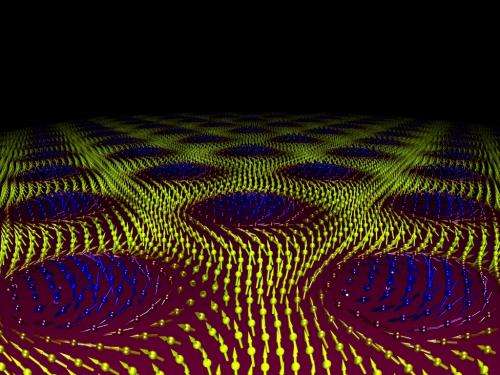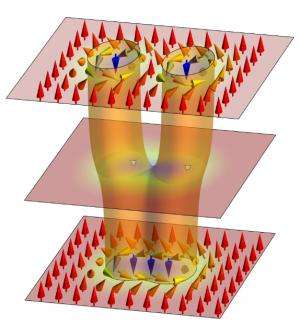Artificial magnetic monopoles discovered

A team of researchers from Cologne, Munich and Dresden have managed to create artificial magnetic monopoles. To do this, the scientists merged tiny magnetic whirls, so-called skyrmions. At the point of merging, the physicists were able to create a monopole, which has similar characteristics to a fundamental particle postulated by Paul Dirac in 1931. In addition to fundamental research, the monopoles may also have application potential. The question of whether magnetic whirls can be used in the production of computer components one day is currently being researched by a number of groups worldwide.
When a magnet is divided, a new magnet with north and south poles is always created. However, a monopole, i.e. a north pole without a south pole or a south pole without a north pole has not yet been discovered. In the current edition of the journal Science, researchers from Cologne, Munich and Dresden describe the discovery of new type of artificial monopole in a solid, i.e. particles, which have similar characteristics to monopoles, but which only exist within materials.
Over the last few years, materials in which magnetic whirls, so-called skyrmions, are formed, have been examined intensively. These whirls influence the movements of the electrons in exactly the same manner as magnetic fields. For this reason, artificial magnet fields are used to describe these whirls as well as their influence on the electrons.
Even if these are not "real" magnetic fields, it is possible to measure them experimentally in the same manner as normal magnet fields as they deflect electrons.
The researchers asked questions as to the consequences of attempting to destroy the magnetic whirls. To do this, the group working under the direction of Prof. Eng from the Technischen Universität Dresden observed magnetic whirls with a magnetic force microscope: a tiny magnetic tip samples the surface of the magnets and measures the direction of the magnetization thus making the ca. 50 nanometer sized whirl visible. They were able to observe on the surface that the magnetic whirls apparently coalesce when the skyrmion phase is destroyed.
What happens, however, within the materials? Measurements taken by the group working under the direction of Prof. Pfleiderer in Munich using neutron scattering suggest that similar processes occur there, but individual whirls were not observed in this manner. For this reason, Stefan Buhrandt and Christoph Schütte working in Prof. Rosch's group at the University of Cologne conducted computer simulations. These showed that the whirls neighbouring the merging process observed on the surface in the experiment also occur within the materials.

The image schematically shows how two magnetic whirls merge into one.
Due to the fact that every whirl carries an artificial magnetic field, their creation or destruction occurs at the point of merging. "This means that an artificial magnetic monopole has to sit on this point," describes Prof. Rosch, "whenever two magnetic whirls merge in the experiment, an artificial magnetic monopole has flown through surface."
Magnetic monopoles have been searched for in vain in the area of particle physics for a long time. In 1931, Paul Dirac postulated the existence of a fundamental particle to explain why electrons and protons carry electrical charges of the same size. This is surprising because the elements of the protons and electrons are completely different fundamental particles. Dirac, however, argued that the existence of a single magnetic monopole would be enough to explain that the charges of all fundamental particles have to be quantized, i.e. exactly an integer multiple of an elementary charge. The newly discovered artificial monopoles fulfil exactly this quantization requirement. "It is fascinating that something as fundamental as a magnetic monopole can be realized in a piece of material," describes Stefan Buhrandt. Despite this, artificial monopoles cannot solve Dirac's problem: only electrons in solid state, but not protons, feel the artificial magnet fields.
In addition to their use for fundamental research, artificial monopoles could also have application potential. Many groups worldwide are currently researching the question of whether magnetic whirls could be used in the production of computer components. If this were possible, one would also have to create and destroy whirls: magnetic monopoles would then play an important role in this.
More information: "Unwinding of a Skyrmion Lattice by Magnetic Monopoles" Science, 2013
Journal information: Science
Provided by University of Cologne




















